Lamrim Authors’ Biographies
The following are very brief biographies of the authors of the eighteen Lamrim commentaries which His Holiness the Dalai Lama taught during the Jangchup Lamrim Teachings.
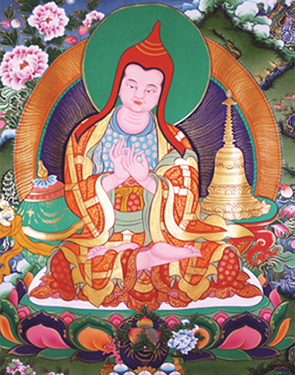
Lama Atisha Dipamkara, author of Lamp for the Path to Enlightenment
Lama Atisha Dipamkara (982–1054)
Lama Atisha Dipamkara was a great Indian scholar credited with the propagation of the Lamrim and Lojong (mind training) teachings that later became the core of the Gelug tradition. He was born to a powerful Bengali family in India, and at 18 months old he already showed a propensity for the Dharma. He was ordained at the age of 29 and became a great scholar and practitioner of sutra and tantra receiving both Nagarjuna’s wisdom lineage and Asanga’s method lineage which he unified and would later bring to Tibet.
In search of a Guru to teach him about bodhicitta he journeyed to Indonesia for 13 months in a boat, remaining there for twelve years studying the Perfection of Wisdom sutras and Shantideva’s lineage of bodhicitta with Master Serlingpa, whom he said was the kindest of all his many teachers. At age 45 he returned to the Indian monastic university of Vikramashila and became one of the most important scholars in all of India. Around 1040, he was invited to Tibet, where he spent at least 13 years helping to revitalize the Buddhist tradition, and where he wrote his text Lamp for the Path to Enlightenment which became the model for all subsequent Lamrim texts. Atisha entrusted this Lamrim lineage to his closest disciple, the Tibetan layman Dromtonpa who established Reting Monastery.
Compiled from: Liberation in the Palm of Your Hand by Pabongka Rinpoche / Trijang Rinpoche, translated by Michael Richards, Wisdom Publications; The Path to Enlightenment by His Holiness the Fourteenth Dalai Lama, translated by Glen Mullin, Snow Lion/Shambhala Publications; and “Alexander Gardner, Atisha Dīpaṃkara,” Treasury of Lives, accessed May 11, 2012.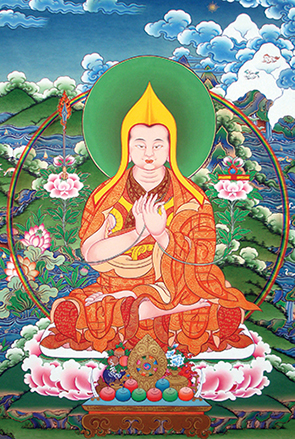
Je Tsong Khapa, Lobsang Drakpa, author of several Lamrim texts including The Great Treatise on the Stages of the Path to Enlightenment
Je Tsong Khapa, Lobsang Drakpa (1357–1419)
Je Tsong Khapa, Lobsang Drakpa, was the founder of the Gelug tradition and one of the most influential Tibetan Buddhist scholars of the last millennium. He was born in the Tsongkha region of Amdo. At age 7 he received novice ordination and the name Lobsang Dragpa Pal. Later he moved to Lhasa and studied with more than 50 teachers of all Tibetan Buddhist traditions, including his spiritual master Rendawa.
At age 24 he received full ordination, and at age 37 he went with eight of his greatest students to the region of Olkar where he spent many years in retreat, teaching and debating on the meaning of the sutras and tantras, which resulted in a deep understanding of Nagarjuna’s Madhyamaka view. In his forties he composed both Lamrim Chenmo (The Great Treatise on the Stages of the Path) and Ngarim Chenmo (The Great Treatise on the Tantric Stages of the Path). In 1409 he instituted the Great Prayer Festival in Lhasa, and in 1411 he founded Ganden Monastery, which eventually became the largest monastery in Tibet. Widely regarded as an emanation of Manjushri, Je Tsong Khapa composed eighteen volumes of works, of which the majority dealt with tantric subjects. Among his many famous students were his two principle disciples, Khedrub Je and Gyaltsab Je, and H.H. the First Dalai Lama Gendun Drub.
Compiled from: The Great Dictionary of the White Conch (dung dkar tshig mdzod chen mo); A Glossary of Successive Tibetan Scholars published in Tibet; The Biographies of the Lineage Lamas of Lamrim compiled by Yongdzin Yeshe Gyaltsen; (all above sections translated by Simon Houlton, 2012); Joona Repo, “Tsongkhapa Lobzang Drakpa,” Treasury of Lives, accessed May 04, 2012.
Ngawang Drakpa of Dagpo, author of The Essence of Fine Speech
Ngawang Drakpa of Dagpo (15th century)
Ngawang Drakpa of Dagpo, also known as Gomchen Ngawang Drakpa, was born in the Tsang region of Tibet in the 15th century. He became a great scholar and tantric adept having studied the great texts under the preeminent Gelugpa masters of the day, including Gyaltsab Je, Khedrub Je, and Choeje Lodro Tenpa.
A wandering monastic community called Dagpo Dratsang had formed under his teacher, Je Lodro Tenpa, with the monks travelling from monastery to monastery debating as they went. Je Lodron Tenpa entrusted this community to Ngawang Drakpa and under his abbotship they finally settled at Gyatsa in Dagpo under the name of Thösamling. This was the first monastic university for advanced studies in Buddhist philosophy in Dagpo, and it later became known as Dagpo Shedrub Ling. Ngawang Drakpa’s collected works comprise 19 volumes.
Compiled from:The Great Dictionary of the White Conch (dung dkar tshig mdzod chen mo); A Glossary of Successive Tibetan Scholars published in Tibet; The Biographies of the Lineage Lamas of Lamrim compiled by Yongdzin Yeshe Gyaltsen; (all above sections translated by Simon Houlton, 2012); The Dagpo Educational Fund; Tibetan Buddhist Resource Center.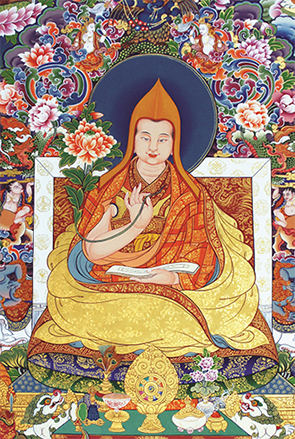
His Holiness the Third Dalai Lama, Sonam Gyatso, author of The Essence of Refined Gold
His Holiness the Third Dalai Lama, Sonam Gyatso (1543–1588)
His Holiness the Third Dalai Lama, Sonam Gyatso, was born to a wealthy family in the Tolung valley near Lhasa. He was recognized at the age of 4 as the reincarnation of Gedun Gyatso and taken to Drepung Monastery for his education. At the age of 34 he was invited to Mongolia by Altan Khan, the 17th in a line of Mongolian kings, who bestowed on him the name “The All-Knowing Conqueror Sonam Gyatso, Vajradhara Dalai Lama”. He was the first in the line of incarnations to be given this title of “Dalai Lama”, which literally means Ocean of Wisdom, and he was instrumental in what is known as “the second conversion of the Mongols”, which spread the Gelug teachings throughout the region.
His Holiness the Third Dalai Lama served as the abbot of Drepung Monastery and Sera Monastery, and founded several important Gelug monasteries, including Kumbum Monastery (in Je Tsong Khapa’s birthplace), Litang Ganden Tubchen Chokorling in Kham, and Namgyal Monastery which remains to this day the Dalai Lama’s personal monastery, assisting him in his various religious activities.
Compiled from: The Great Dictionary of the White Conch (dung dkar tshig mdzod chen mo); A Glossary of Successive Tibetan Scholars published in Tibet; The Biographies of the Lineage Lamas of Lamrim compiled by Yongdzin Yeshe Gyaltsen; (all above sections translated by Simon Houlton, 2012); www.dalailama.com; Miranda Adams, “The Third Dalai Lama, Sonam Gyatso,” Treasury of Lives, accessed May 02, 2012.
Panchen Lobsang Chokyi Gyaltsen, author of The Easy Path
Panchen Lobsang Chokyi Gyaltsen (1570–1662)
Panchen Lobsang Chokyi Gyaltsen was born in a district of Tsang in central Tibet. He was recognized at the age of 5 as the reincarnation of Ensapa Lobsang Dondrup and received monastic ordination at 13. He received his philosophical education at Tashilhunpo monastery where he later became the abbot. He helped institute the Geshe Lharampa degree system, and was a teacher to many important Tibetan, Bhutanese and Mongolian political and religious figures including the First Jetsun Dampa of Mongolia. He was the personal tutor to H.H. the Fourth Dalai Lama and a teacher and ordination master of H.H. the Fifth Dalai Lama.
He was posthumously given the title ‘Panchen’, meaning ‘Great Scholar’ by H.H. the Fifth Dalai Lama, who declared him an emanation of Amitabha. Though he was the first to receive this title, he is sometimes considered the Fourth Panchen, counting three previous incarnations, beginning with Khedrub Je, one of Je Tsong Khapa’s closest disciples. He is credited with over a hundred compositions which include a number of commentaries and ritual texts that remain central to the Gelug tradition.
Compiled from: The Great Dictionary of the White Conch (dung dkar tshig mdzod chen mo); A Glossary of Successive Tibetan Scholars published in Tibet; The Biographies of the Lineage Lamas of Lamrim compiled by Yongdzin Yeshe Gyaltsen; (all above sections translated by Simon Houlton, 2012); Alexander Gardner, “The First Paṇchen Lama, Lobzang Chokyi Gyeltsen,” Treasury of Lives, accessed May 02, 2012.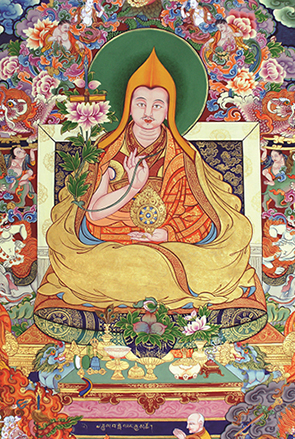
His Holiness the Fifth Dalai Lama, Lobsang Gyatso, author of The Sacred Words of Manjushri
His Holiness the Fifth Dalai Lama, Lobsang Gyatso (1617–1682)
His Holiness the Fifth Dalai Lama, Lobsang Gyatso, was born in the Lhoka region of Tibet and recognized at the age of 6 as the reincarnation of H.H. the Fourth Dalai Lama by Panchen Lobsang Chokyi Gyaltsen. At the age of 25 he became the first Dalai Lama to be enthroned as both the spiritual and political leader of the whole of Tibet, with the establishment of the Gaden Podrang government.
He is remembered amongst all Tibetan Buddhist traditions as “The Great Fifth” and is renowned as a brilliant scholar and writer who authored 26 volumes of commentaries, Tantric ritual manuals, histories, and biographies, as well as being an accomplished meditator, medical doctor and poet. Desi Sangye Gyatso and Jamyang Shepa were amongst his most famous students. He established for the first time in Tibet many beneficial modern infrastructures such as a National Medical College and national healthcare system; a taxation system to support education, medical care and environmental projects; a population census; map surveys; and the building of the world-famous seat of all future Dalai Lamas, the Potala Palace.
Compiled from: The Great Dictionary of the White Conch (dung dkar tshig mdzod chen mo); A Glossary of Successive Tibetan Scholars published in Tibet; The Biographies of the Lineage Lamas of Lamrim compiled by Yongdzin Yeshe Gyaltsen; (all above sections translated by Simon Houlton, 2012); www.dalailama.com and “The Fourteen Dalai Lamas: A Sacred Legacy of Reincarnation” by Glen Mullin, Jaico Publishing House.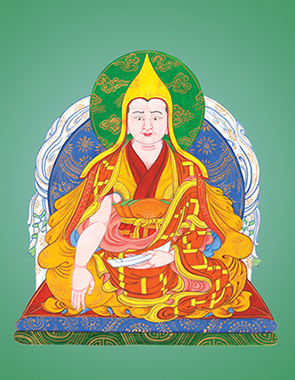
Je Gendun Jamyang, author of The Southern Lineage
Je Gendun Jamyang
Je Gendun Jamyang was a great tantric practitioner who completed his main studies at Yarlung Ribo Choeling and Dagpo Monasteries. He received the complete experiential transmission of The Southern Lineage from Je Ngawang Tendar of Epa. This text is a series of annotated notes on a shortened version of The Sacred Words of Manjushri by H.H. the Fifth Dalai Lama himself, who marked certain passages of the main text for compiling as a separate concise text. Je Gendun Jamyang was encouraged to write this annotated text of The Southern Lineageand then passed the lineage on to his disciple Je Ngawang Tutob, who in turn passed in on to Tenpa Gyatso, Abbot of Dagpo college. By writing down these notes, Je Gendun Jamyang ensured that there remains to this day an unbroken lineage of the Southern Lineage Lamrim tradition.
Compiled from: A Brief History of Dagpo Monastery (this section translated by Simon Houlton, 2012) and Liberation in the Palm of Your Hand by Pabongka Rinpoche, edited by Trijang Rinpoche and translated by Michael Richards, Wisdom Publications.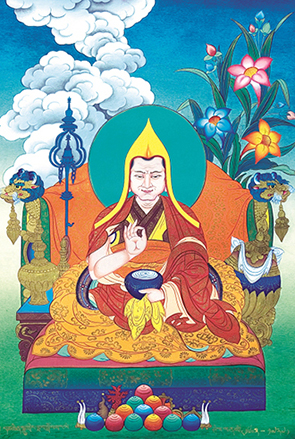
Panchen Lobsang Yeshe, author of The Swift Path
Panchen Lobsang Yeshe (1663–1737)
Paṇchen Lobsang Yeshe was born in the Tobgyal district of Tsang in central Tibet. He was recognized by H.H. the Fifth Dalai Lama within a year of his birth as the reincarnation of Panchen Lobsang Chokyi Gyaltsan. He received his novice vows from H.H. the Fifth Dalai Lama and his religious education from many leading scholars of the day. He later gave novice vows and was a teacher to H.H. the Sixth and Seventh Dalai Lamas and had many other well-known disciples including Yongling Yeshe Gyaltsen and Jangkya Rinpoche Yeshe Tenpai Dronmey.
At the age of fifty-one the Chinese Qing Dynasty Manchu Emperor issued an edict giving him the title of “Ertini”, Mongolian for “Rinpoche” or “Precious One”, and since then all subsequent Panchen Lamas have been known as the Panchen Ertini. Panchen Lobsang Yeshe traveled widely, teaching as he went, and composed four volumes of commentaries. He was the head of Tashilhunpo Monastery for sixty-eight years before passing away there in 1737, where his complete body is preserved in a great stupa.
Compiled from: The Great Dictionary of the White Conch (dung dkar tshig mdzod chen mo); A Glossary of Successive Tibetan Scholars published in Tibet; The Biographies of the Lineage Lamas of Lamrim compiled by Yongdzin Yeshe Gyaltsen; (all above sections translated by Simon Houlton, 2012); www.rigpawiki.org.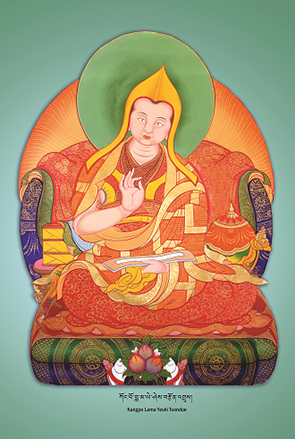
Kongpo Lama Yeshe Tsondru, author of The Essence of Nectar
Kongpo Lama Yeshe Tsondru (1761–1816)
Kongpo Lama Yeshe Tsondru was a meditator who had a reputation for being a great practitioner of the Dharma. As a lay child he studied reading and writing at which he excelled, and at age 9 he was sent to Lhasa to also learn astrology and religious practice. At 17 years old he took novice ordination with Panchen Palden Yeshe and at 18 he entered Drepung Loseling Monastery to begin his studies of the five great groups of texts. Later, on the advice of Kachen Yeshe Gyaltsen, he spent a considerable period of time practicing single-pointedly in remote retreat locations in Central Tibet and Kongpo. At the age of 51 he established Kongpo Gaden Samten Ling and regularly gave commentarial explanation on the Stages of the Path. He composed ten works.
Compiled from: The Great Dictionary of the White Conch (dung dkar tshig mdzod chen mo); A Glossary of Successive Tibetan Scholars published in Tibet; The Biographies of the Lineage Lamas of Lamrim compiled by Yongdzin Yeshe Gyaltsen (all above sections translated by Simon Houlton, 2012)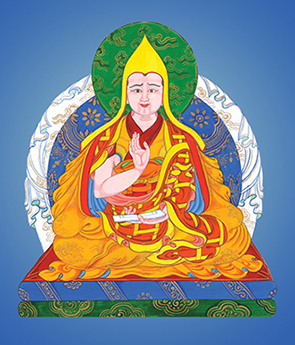
The Fourth Amdo Zhamar, Gendun Tenzin Gyatso, author of Treatise on the Stages of the Path to Enlightenment and Treatise on Special Insight
The Fourth Amdo Zhamar, Gendun Tenzin Gyatso (1852–1912)
The Fourth Amdo Zhamar, Gendun Tenzin Gyatso, was born in lower Kham, Tibet, and recognized at an early age as the reincarnation of the Third Amdo Zhamar. He was ordained at age 8 and Je Sherab Gyatso became his main personal tutor, instructing him in the five great treatises. He received full ordination at 20 and took many teachings from great scholars of the day, principal among them Kyabje Arol Rinpoche. For many years he spent the winters in single-pointed retreat and the summers receiving Dharma teachings at Labrang Tashi Kyil.
He drew hundreds of new retreatants to Ditsa hermitage for meditation and in 1903 he helped found Gendun Tashi Choling, part of the upper Ditsa Monastery, which became famous due to the new philosophical curriculum he established there. He became such a great scholar in all five fields of knowledge that when H.H. the Thriteenth Dalai Lama visited Kubum monastery he bestowed on Zhamar Rinpoche the name “King of the Dharma, Mahapandita”. His writings fill 9 volumes including many works on Lamrim, the Perfection of Wisdom, and the middle-way philosophy.
Compiled from:Zhamar Pandita’s biography contained within the Zhamar Lamrim (published by Gomang monastery; this section was translated from the Tibetan by Simon Houlton, 2012); Heather Stoddard, “Gendun Chopel,” Treasury of Lives, accessed May 03, 2012 and Tibetan Buddhist Resource Center.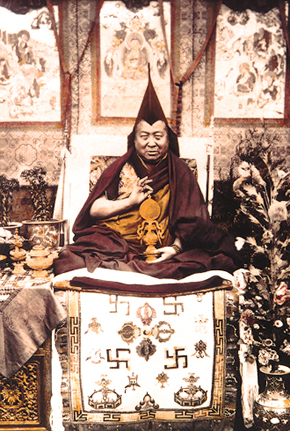
Pabongka Rinpoche, Jampa Tenzin Trinlay Gyatso, speaker of Liberation in the Palm of One’s Hand
Pabongka Rinpoche, Jampa Tenzin Trinlay Gyatso (1878–1941)
Pabongka Rinpoche, Jampa Tenzin Trinlay Gyatso, was one of the great lamas of the twentieth century. He held all of the important lineages of sutra and tantra and passed them on to the most important Gelug lamas of the next two generations. He was the root guru of Ling Rinpoche and Trijang Rinpoche, the two tutors of H.H. the Fourteenth Dalai Lama.
He was born in Yuthog near Lhasa in 1878. When he was 7 years old his mother requested an audience with Sharpa Choeje Lobsang Dhargay who divined that this was indeed an exceptional child, and under his guidance Pabongka Rinpoche was enrolled in Sera Mey Monastery at the age of 8. There he studied the great texts and sat for his final debate exams at age 19, following which he enrolled in Gyuto Tantric College for 3 years. He later received teachings and transmissions from many great masters, including Dagpo Lama Jamphel Lhundrup and Dagri Dorje Chang, on all aspects of sutra and tantra. His collected works occupy twelve volumes covering all aspects of Buddhism.
Compiled from: The Great Dictionary of the White Conch (dung dkar tshig mdzod chen mo); A Glossary of Successive Tibetan Scholars published in Tibet; The Biographies of the Lineage Lamas of Lamrim compiled by Yongdzin Yeshe Gyaltsen; (all above sections translated by Simon Houlton, 2012); Lama Yeshe Wisdom Archive, and the Translator’s Introduction to Liberation in the Palm of Your Hand by Pabongka Rinpoche, edited by Trijang Rinpoche and translated by Michael Richards, Wisdom Publications.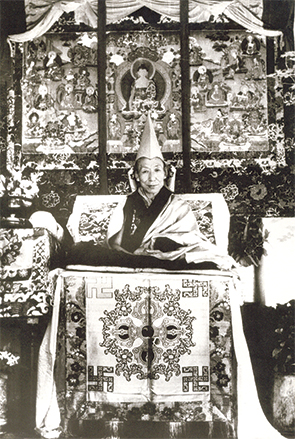
Trijang Rinpoche, Lobsang Yeshe Tenzin Gyatso, compiler of Liberation in the Palm of One’s Hand and author of The Textual Outline for the Medium Treatise on the Stages of the Path to Enlightenment
Trijang Rinpoche, Lobsang Yeshe Tenzin Gyatso (1901–1981)
The Third Trijang Rinpoche, Lobsang Yeshe Tenzin Gyatso, was one of the most prominent Gelug teachers of the twentieth century. Virtually every Gelug teacher today has received teachings or empowerments from Trijang Rinpoche or from one of his direct students.
He was born near Lhasa in 1901 and recognized at age of 4 by the H.H. the Thirteenth Dalai Lama, who gave him full ordination when he was 19 years old. He studied the great texts for 12 years under his main teacher Phulkhang Nangsang Lobsang Tsultrim, and received many teachings and transmissions from the great Lamas of the day, including Serkong Dorje Chang, Pabongka Rinpoche, and Ling Rinpoche. He was the assistant for H.H. the Fourteenth Dalai Lama’s novice ordination and accompanied him on visits to China and India, and eventually into exile in India in 1959. In 1954 he was appointed as H.H. the Fourteenth Dalai Lama’s philosophical assistant and was his personal junior tutor for more than forty years. Tijang Rinpoche taught in many of the great monasteries and institutes in exile in India, and later traveled to many countries such as the United Kingdom, France, Germany and Switzerland, teaching and giving empowerments.
Compiled from: Joona Repo, “The Third Trijang, Lobzang Yeshe Tendzin Gyatso,” Treasury of Lives, accessed May 03, 2012, FPMT and A Dharma History of Ganden Shartse (this section translated by Simon Houlton, 2012). This list of brief biographies was compiled by S. Houlton and M. Mouldin in 2012 from the sources cited above. All errors are theirs alone.